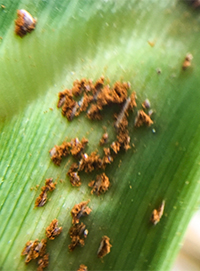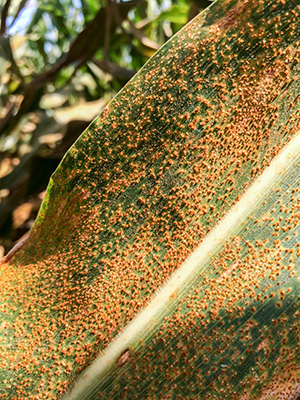Southern rust (also known as Polysora rust) is favored by high relative humidity and high temperatures and therefore tends to be confined to tropical and subtropical regions more than common rust. In seasons with higher than average temperatures, southern rust can spread into temperate regions where it can impact corn yield.
Timing
 In North America, southern rust usually occurs later in the growing season and is more prevalent in the southern states. Southern rust does not occur as often from year to year as common rust, but it is usually more severe when it does occur.
In North America, southern rust usually occurs later in the growing season and is more prevalent in the southern states. Southern rust does not occur as often from year to year as common rust, but it is usually more severe when it does occur.
Management tips
If applied properly and in a timely manner, fungicide treatments can be effective in protecting corn leaves from foliar diseases. Whether the treatment will provide an economic return is often difficult to predict. To help with this decision, the University of Illinois gives the following fungicide treatment guidelines for rust and other foliar diseases (Bissonnette, 2000):
- The disease can develop very rapidly during warm, humid conditions.
- At that point, at least a 15% whole-plant infection is needed to justify a fungicide treatment.
- Also consider these factors to make a reasonable decision:
- First, consider the weather. Fungi in general and rusts in particular need free water (on the leaves) and continued wet weather to continue to flourish.
- Next, consider the probability of other fungal leaf blights developing in the field and in your particular hybrid. Cropping history and corn residue levels can affect development of diseases such as gray leaf spot.
- Consider the price of corn and cost per application.
Keep records of potential outbreaks throughout the season. Recording scouting notes and field observations in a tool like Granular Insights are helpful for planning in-season rescue applications and serve as a historical record of location, severity and time of outbreaks for next year's planning.
Impact on yield
Both rust diseases of corn can cause substantial yield losses under severe disease pressure; however, southern rust generally poses a greater risk to corn yield than common rust. Yield loss due to rust depends on timing of infection, amount of leaf area damaged, and location of damaged leaves on the plant. If significant damage to upper leaves occurs early in the life of the hybrid, yield losses will be higher. If damage is confined to lower leaves of the corn plant or occurs in the later reproductive stages of development, little economic loss would be expected. Consequently, the latest-planted corn in an area is at higher risk for yield loss due to leaf diseases.
Common rust usually does not reach levels in the Corn Belt that would justify a fungicide application; however, severe infections can occur under conditions favorable for disease development. Such conditions were experienced in several Midwestern states in 2009, a growing season that was characterized by lower than normal temperatures throughout much of July and August (Lutt et al., 2016). Pioneer fungicide research trial locations in Illinois and Indiana experienced intense common rust pressure in 2009. At one research location in Indiana, the average yield response to fungicide treatment was over 22 bu/acre (Jeschke, 2017). Yield response to fungicide treatment varied greatly with common rust pressure at the research locations and hybrid genetic resistance to common rust.

Symptoms
Southern rust looks very similar to common rust, but several characteristics distinguish the two. Southern rust pustules are usually confined to the upper leaf surface, while common rust is found on both upper and lower surfaces. Southern rust is more orange or reddish-orange in appearance, while common rust is red or cinnamon-brown. Southern rust pustules have a circular appearance, while those of common rust have an elongated, jagged appearance.
Conditions for development
The disease can develop very rapidly during warm, humid conditions.
Get Your Disease ID Guide
Learn the timing, signs and treatment for common crop diseases with the Corn & Soybean Disease ID Guide.
Aproach® and Aproach® Prima are not registered for sale or use in all states. Contact your state pesticide regulatory agency to determine if a product is registered for sale or use in your state. Always read and follow label directions.